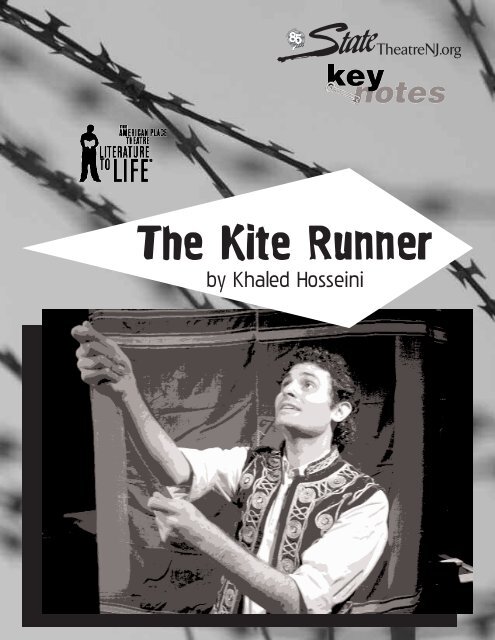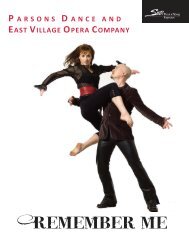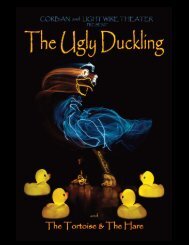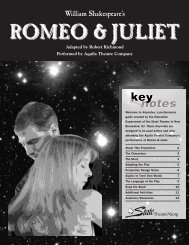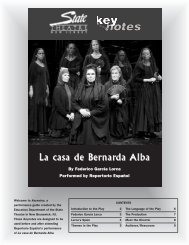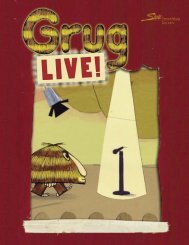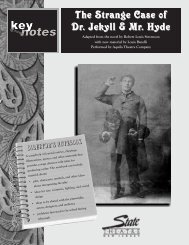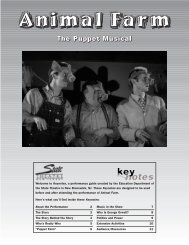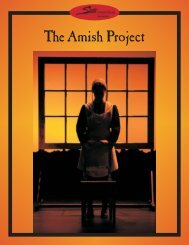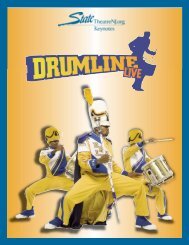The Kite Runner - State Theatre
The Kite Runner - State Theatre
The Kite Runner - State Theatre
You also want an ePaper? Increase the reach of your titles
YUMPU automatically turns print PDFs into web optimized ePapers that Google loves.
<strong>The</strong> <strong>Kite</strong> <strong>Runner</strong>by Khaled Hosseini
About the Show2<strong>The</strong> performance of <strong>The</strong> <strong>Kite</strong> <strong>Runner</strong> is adramatization of scenes from Khaled Hosseini’s novel ofthe same name. <strong>The</strong> words spoken by actor ArianMoayed come directly from the book; though some ofthe text has been cut or rearranged, nothing has beenadded that does not appear in the book. <strong>The</strong> one actorportrays all of the characters that appear in the part ofthe novel included in the performance.<strong>The</strong> performancedoes not coverthe entire novel,but focuses onevents fromchapters 1-8.<strong>The</strong> performance takes place on a stage that is bare except for a stool drapedwith a piece of Afghani cloth. Authentic Afghan rubab (an instrument similar to alute) music is played before and after the show. Otherwise, it’s just the actor, thescript, and the audience’s imagination that bring the story to life.<strong>The</strong> <strong>Kite</strong> <strong>Runner</strong> is told from the point of view of Amir, a young man from aprosperous Afghan family. As an adult living in the U.S., Amir is troubled by guiltover an incident that happened when he was a child living in Kabul, Afghanistanin 1975. Finding himself in a difficult situation, he betrayed his best friend,Hassan, the son of his father’s servant. <strong>The</strong> story is set against a backdrop oftumultuous events, from the fall of the monarchy in Afghanistan through theSoviet invasion, the mass exodus of refugees to Pakistan and the United <strong>State</strong>s,and the Taliban regime.Meet the ActorArian Moayed is an actor, writer, anddirector. He is a co-founder of theaward-winning theater company,Waterwell, where he has worked onproductions of Choo! Choo!, In On It, Lostin Yemen, Fuenteovejuna, Chill & Serve,and Sweetness & Light. His other NewYork theater credits include thepremieres of American Pilot atManhattan <strong>The</strong>ater Club and JeffDaniels’ Apartment 3A, Glyn O’Malley’sParadise , Betty Shaimeh’s Again andAgainst, and Tony Kushner’s Homebody/Kabul (BAM). Outside of New York,Arian has performed in Homebody/Kabul (Steppenwolf) and As You Like It andOthello (Utah Shakespearean Festival) His film and television appearancesinclude Law & Order, Law and Order: Criminal Intent, Phileine Says Sorry, Sexand the City, Tough Crowd with Colin Quinn, and Late Nite with ConanO’Brien. Look for him in Spike Lee’s upcoming TV series, M.O.N.Y. Arian alsoreads for National Public Radio’s Selected Shorts.Adaptation: Page to Stage<strong>The</strong> performance covers only parts ofthe book. What criteria might theadapters have used in deciding what toinclude and what to leave out? Do youthink they made good choices?If you were hired to turn <strong>The</strong> <strong>Kite</strong><strong>Runner</strong> into a stage play or movie, howwould you adapt it? In your adaptation,would you tell any of the story from thepoint of view of any of the charactersbesides Amir? Would you add any scenesthat are not in the book? Leave anythingout? Why?Judging aBook byIts CoverTake a lookat the cover of<strong>The</strong> <strong>Kite</strong> <strong>Runner</strong>at your locallibrary or online.(<strong>The</strong>re havebeen severaldifferent covers,including the one at right.) Is there apicture or an image on the cover? Whatdo these images mean to you? Do theseimages make you want to read the bookor give you an idea of what it is about?Why did Khaled Hosseini choose thistitle? Which character does it refer to?Does the title give you insight into thestory? What other words or phrases areon the cover?Create a poster or book cover for <strong>The</strong><strong>Kite</strong> <strong>Runner</strong>. You can cut images out ofmagazines and newspapers or draw them.What words and images will you includeand why?
<strong>The</strong> Story3What Happens in the Play?Amir, a 38-year-old Afghan man living in the U.S., looks back on a disturbingincident that took place when he was 12 years old and living with his father inKabul, Afghanistan. Though he has tried to forget what happened, he continuesto be haunted by guilt. He tells his story in flashback.As a boy in the 1960s, the young Amir enjoys a life ofprivilege. He is a Pashtun, the ruling tribal group ineastern and southern Afghanistan. His best friend,Hassan, is the son of the family servant Ali. Ali andHassan are Hazara, a minority tribe that has sufferedsevere ethnic discrimination under the Pashtuns. Hassanworships Amir and defends him from Assef, a big, cruelboy who believes in the racist ideas of Adolph Hitler.A shy child who is bad at sports, Amir believes that heis a failure in his father’s eyes. Striving to win hisCharacters in the PerformanceBoth Pashtunsand Hazaras areMuslims; thePashtuns arepredominantlySunni, whileHazaras arepredominantlyShiite.fatherÕs approval, he places all his hopes on winning a kite-flying tournamentÑapopular challenge in which participants use the glass-coated strings of their kitesto cut down the other kites. Amir wins the tournament and sends Hassan, the“kite runner,” to get the last kite that he has brought down.On his way back with the kite, Hassan is brutally assaulted by Assef in a backalley. From hiding, Amir watches the attack but is too frightened to try to help hisfriend. He runs away, and when he sees Hassan a short time later he pretendsnot to know what happened. Amir’s cowardice marks a turning point in therelationship between the two boys.<strong>The</strong> following characters speak or are mentioned in the play.AMIR - the narrator of the story; a young Afghani man from a prominentPashtun familyHASSAN - a Hazara boy, friend and servant of Amir. He has a harelip, a type offacial deformity.BABA - Amir’s fatherALI - a Hazara man, one of Baba’s servants. He is believed to be Hassan’sfather, until Hassan’s true parentage is revealed later in the book.SANAUBAR - Hassan’s mother, who ran away right after he was bornASSEF - a Pashtun boy (his mother is German) who bullies Amir and HassanWALI & KAMAL - friends of Assef who help him assault HassanA MERCHANTRAHIM KHAN - Baba’s best friend and business partnerGetting Under theCharacters’ SkinWorking with threeor four of yourclassmates, pickone charactersthat you wereintroduced toin theperformanceof <strong>The</strong> <strong>Kite</strong><strong>Runner</strong>. Create anoutline of a body bydrawing it onto alarge sheet ofposterboard orkraft paper. Thisrepresents the character you havechosen.On the inside of the body, write wordsor phrases that capture the internal worldof your character—thoughts, feelings,emotions, history, or anything that takesplace internally. On the outside of thebody, write words or phrases that capturethe external world of the character—including what people think of thischaracter, what this character shows tothe world, the physical appearance of thecharacter, external influences orenvironment, other people and situationsthat the character interacts with, andanything else external.After your group has completed youroutline, tape it on the wall. Present andexplain your character outline to the restof the class. Let them ask questionsabout your character. Does everyone elsesee your character in the same way yourgroup did?
Exploring <strong>The</strong> Novel4Meet the Author<strong>The</strong> oldest of five children, Khaled Hosseiniwas born in 1965 in Kabul, Afghanistan. Hismother was a teacher of Farsi and historyat a large girls’ high school in Kabul. Hisfather was a diplomat, and when he wasposted to the Afghan Embassy in Paris in1976 he moved there with his entire family.In 1980, following the 1978 coup andRussian invasion of Afghanistan, the United<strong>State</strong>s granted the Hosseini family politicalasylum. <strong>The</strong>y moved to San Jose, California. Khaled Hosseini attended SantaClara University and graduated from the UC San Diego School of Medicine. Hehas been in practice as an internist since 1996. He is married and has twochildren (a boy and a girl, Haris and Farah). <strong>The</strong> <strong>Kite</strong> <strong>Runner</strong> is his first novel.Dear Friends,Many readers see my novel, <strong>The</strong> <strong>Kite</strong> <strong>Runner</strong>, as a book aboutAfghanistan, a story of its violent recent past, its tragedies andupheavals, its rich culture and resilient people. <strong>The</strong>y tell me thatthis book opened for them an intimate window into my troubledhomeland, and that news stories about Afghanistan suddenlyregistered with them on a deep and personal level. <strong>The</strong>y ask me ifthis was my intent in writing this book. And I tell them it was. Butnot that first day, in March of 2001, when I sat to write the openingwords of this book. For me, writing has always been, first andforemost, about storytelling. <strong>The</strong> <strong>Kite</strong> <strong>Runner</strong> came about simplybecause I was bewitched by a story. A story of guilt and redemption,brutality and kindness, sin and forgiveness, a story of the doomedfriendship between two boys, one rich, one poor, one flawed, theother pure, with Afghanistan and her own tale of brutality andkindness as the backdrop. It was always, first and last, about story.And stage has always been a unique and powerful medium forstorytelling, direct and intimate, organic and spontaneous. And so Ithank <strong>The</strong> American Place <strong>The</strong>atre for selecting the story of Amirand Hassan, two boys who lived in my mind and are dear to myheart. I am grateful and thrilled. Thank you for honoring me withthis performance.—Khaled HosseiniLetter written to <strong>The</strong> American Place <strong>The</strong>atre - April 12, 2005Formative MomentsI became what I am today at the ageof twelve, on a frigid overcast day inthe winter of 1975. I remember theprecise moment, crouching behind acrumbling mud wall, peeking into thealley near the frozen creek. That was along time ago, but it’s wrong whatthey say about the past, IÕve learned,about how you can bury it. Becausethe past claws its way out. Lookingback now, I realize I have been peekinginto that deserted alley for the lasttwenty-six years.In this excerpt from <strong>The</strong> <strong>Kite</strong> <strong>Runner</strong>,Amir describes a moment from hischildhood that formed his adult self. Thinkback over things that happened to youwhen you were younger. What is the oneevent or moment in your childhood thatyou predict you’ll look back on when you’re40 years old and say, “That’s the momentthat made me the person I am today.”?<strong>The</strong>n write down on a piece of paper:1. “I became what I am today at the ageof __________.”2. “I remember the precise moment. I waswith __________.”3. “What happened was __________.”4. “At the time it happened, I felt__________.”5. “Looking back now, I realize that thereason I am __________ today isbecause of that event.”Fill in the blanks with the details of yourformative moment. Do not put your nameon the paper. Have your teacher collect allthe papers in your class and re-distributethem so that everyone ends up withsomeone else’s formative moment.Using the information you’ve beengiven, write a poem or short story basedon the formative moment in the life of oneof your classmates.
Making Personal Connections5Before the Show: Yes, No, MaybeDivide your classroom into three equal sections. Designate thecenter area “Maybe” (or “Not Sure”), and the sides as “Yes” and“No.” When your teacher reads each of the following questions, moveto the part of the room that best represents your answer, movingfarther from the center depending on how strong your opinion iseither “yes” or “no.”• Do you think that you have much in common with a student ofyour age living in Afghanistan?• Have you ever had a good friend who was in a different economicclass than you?• Have you ever had a good friend who was in a different ethnic or racial group than you?• Have you ever had a secret you didn’t share with anyone?• Have you ever formed an opinion about someone based on their skin color, clothing, or accent?• Have you ever regretted a choice that you made?• Have you ever felt like a “bad person”?• Do you think all people have flaws?Before the Show: Circle of QuestionsDivide your class in half: Group A and Group B. Group A forms acircle in the middle of the room. <strong>The</strong>n Group B forms a circle aroundthem. <strong>The</strong> people in Group A then turn around to stand face-to-facewith someone in Group B. Begin by introducing yourself to yourpartner (the person standing in front of you from the opposite group).1. Tell your partner whether you think you will enjoy thereading/viewing <strong>The</strong> <strong>Kite</strong> <strong>Runner</strong> based on its title and what youknow about it so far, and why. <strong>The</strong>n let your partner answer thesame question.2. Everyone in Group B moves one space to the right. Introduce yourself to your new partner.3. You and your partner tell each other about a childhood friend that you no longer speak to. How and why did yougrow apart?4. Everyone in Group A moves three spaces to the left. Introduce yourself to your new partner.5. You and your partner tell each other about a choice that you made that you now regret.6. Everyone in Group B moves five spaces to the left. Introduce yourself to your new partner.7. You and your partner tell each other about a relative that you admire and why.8. Everyone in Group A moves one space to the right. Introduce yourself to your new partner.9. You and your partner tell each other about a time that you lied about something. Do you regret the lie or do youbelieve it had to be done?
Afghanistan and Its Culture6Afghanistan is a landlocked country, sharing itsborders with Turkmenistan, Uzbekistan, and Tajikistan tothe north, China to the northeast, Pakistan to the eastand south, and Iran to the west. <strong>The</strong> countryÕs officiallanguages are Pashtu and Dari Persian. <strong>The</strong> populationof about 30 million people is roughly 42% Pashtun, 27%You can call thepeople ofAfghanistaneither “Afghan”or “Afghani.”Tajik, 9% Hazara, and 9% Uzbek, with the remaining population divided amongAimaq, Turkmen, Baluch, and other small groups. Outside the capital city ofKabul, Afghanistan is still largely a tribal society. Religion and traditional customshave a strong influence within the family, and there are strict male and femaleroles in society.What Do Afghans Like to Do?KITES: In Afghanistan, kite flying is an art and sport at the same time. <strong>Kite</strong>makers take pride in creating kites that can reach up to five feet in size. <strong>The</strong> lineattached to the kite is covered with glue and a fine powder of ground glass. Asthe challengers loft their kites high into the sky, the goal becomes to cross linesand cut the opponent’s kite string with a sawing motion. Children love to chasethe falling kites, which they get to keep. Under the Taliban, making or flying kiteswas forbidden–children were even executed for violating this law.MUSIC: Afghans adore musicÑplaying at weddings, outdoors, or whenever theycan. During the rule of the Taliban, a harsh ban was imposed on music, withpeople subject to imprisonment or even execution for playing, owning, orlistening to music. Now that the Taliban no longer rule, music, folk dances, andcelebrations take place as before.FOOD: Afghani cuisine has been influenced by the cooking of Persia (Iran), India,and Mongolia. Vegetable dishes, rice, meat stews or kebabs, and a flatbreadcalled nan are all part of the menu. Cardamom tea is always served along with arefreshing yogurt drink called doogh on hot days. Desserts such as fresh or driedfruits, nuts, sugared almonds, or chickpeas are nibbled on before meals or with tea.OTHER PASTIMES: Afghans enjoy storytelling, dancing, and children’s games suchas marbles. <strong>The</strong>y like to spend theirweekends with family and friends going topublic parks or to the countryside to enjoythe beautiful surroundings and to havepicnics. <strong>The</strong>ir national sport is buzkashi,which dates back to the 13th century. Thisrough, fast-paced game is similar to polo; itis played on horseback, but uses the carcassof a goat or calf instead of a ball! Othersports popular in Afghanistan are soccer,boxing, volleyball, and basketball.“Batcha” (Afghani boy), by Joe HoytRumi, a 13th-century Persian poet, camefrom Balkh, part of modern-dayAfghanistan.“Bustop,”by Joe Hoyt
Afghanistan Timeline, Part I750,000-20,000 BCE: Archaeological evidenceindicates human civilization is beginning tothrive in the area that will become knownas Afghanistan.500 BCE: Persian leader Darius the Greatextends his empire into modern-dayAfghanistan.329 BCE: Alexander the Great conquersPersia and Afghanistan. Greek rule continuesin much of the area during the next twocenturies, although unrest and revolts arecommon.50 AD: <strong>The</strong> Kushan empire and its Buddhistdoctrines, begin to establish themselves inthe region.550: After years of relative independence,Persian forces reassert control over the area but continue to faceintermittent revolts from native Afghan tribes.652: Arabs introduce the region to Islam, a religion that willeventually become dominant.962: <strong>The</strong> Islamic era begins with the Ghaznavid Dynasty, foundedby Turks and giving rise to Afghanistan’s emerging role politicallyand culturally in Islamic civilization.1030: <strong>The</strong> Ghaznavid empire begins to fall apart after the death ofMahmud Ghazni.1370: A series of ventures to seize power, competing kingdoms andintermittent revolts mark the 14th and 15th centuries.1504: Babur, a founder of India’sMoghul dynasty, takes control ofKabulÐand, in time, much of moderndayAfghanistan. Moghul rule introducesanother religion, Hinduism, to thecountry and sets off more attemptednationalist revolts.1600s: On the heels of the nationalistTURKMENISTANIRANBaburmovement of the previous century ledby Bayazid Roshan, another nationalistmindedrevolt–this one headed by Afghan warrior-poet KhushhalKhan Khattak–begins against the Moghul government in the late1600s.UZBEKISTANKabul AFGHANISTANTAJIKISTANPAKISTANCHINAINDIA1708: Mir Wais Khan Hotak, considered by somethe father of Afghan independence,successfully takes over Kandahar in southernAfghanistan. His son, Mir Mahmud, invadesPersia and liberates Herat. But by 1736, thePersians start to re-establish their grip onthe region.1750s: Ahmad Shah Durrani beginshis rule, consolidating and enlargingAfghanistan while also governingmuch of India. But peace will be theMir Waisexception over the next 100 years, as local leaders fend off Persianand Sikh invasions and fight amongst themselves.1836: <strong>The</strong> British, in corroboration with ex-king Shah Shuja, invadeAfghanistan in response to growing Russian and Persian influencein the region. Afghan forces fight fervently against British forces,and by 1843 the nation reasserts its independence.1878: <strong>The</strong> British launch their second war against Afghanistan, butwithdraw in the face of strong resistance two years later.1885: Russian forces seize territory in northern Afghanistan. <strong>The</strong>Russians will keep most of the area, but thereafter pledge torespect Afghanistan’s territorial integrity. Eight years later, anotherboundary agreement–this one between Afghanistan and BritishIndiaÐleaves several Afghan tribal areas in what is now Pakistan.
Afghanistan Timeline, Part II81921: A third Anglo-Afghan war breaks out after anti-British forcesassassinate the king. But by 1919, the war-weary British relinquishcontrol over Afghanistan’s foreign affairs. <strong>The</strong> new king,Amanullah, establishes diplomatic relations with several majornations and introduces reforms aimed at modernizing thecountry. But the moves alienate many tribal and religious leadersand generate political turmoil.1949: Afghanistan’s parliament refuses to recognize newboundaries drawn by Great Britain establishing an independentPakistan.1973: Daoud Khan and the AfghanCommunist Party overthrow the rulingAfghan government and long-timeking Mohammad Zahir Shah. Daoudabolishes the monarchy, presents anew constitution, ousts suspectedopponents from the government andinstitutes economic and social reforms.Daoud Khan1978: Daoud is killed and hisgovernment falls in a communist-backed coup. Mass killings,arrests and tortures ensue, and the Afghan guerrilla (Mujahideen)movement is born.1979: Anti-communist forces take control, prompting a Sovietinvasion.1984: <strong>The</strong> Mujahideen, known by supporters as “freedomfighters,” begin receiving military and logistical assistance fromthe United <strong>State</strong>s and other countries.1988: <strong>The</strong> Soviet Union and United <strong>State</strong>s sign the GenevaAccords, calling for Soviet withdrawal from Afghanistan and thereturn of refugees without fear of persecution. But theMujahideen do not take part in the negotiations, and do notaccept it.1992: <strong>The</strong> Mujahideen take over Kabul and declare Afghanistanliberated. <strong>The</strong>y form an Islamic state, headed by the Islamic JihadCouncil and Professor Burhanuddin Rabbani.1994: <strong>The</strong> Taliban militia is born and begins to rise up againstRabbani’s government and its supporters. Over the next severalyears, the group will become the nation’s dominant politicalforce, although by 2001 only three other countries recognized itslegitimacy.1996: <strong>The</strong> Taliban, an extremist group of Sunni Muslims, gainscontrol of Kabul. By the end of 2000, they have captured 95% ofAfghanistan. <strong>The</strong>y impose a strict interpretation of Islamic Sharialaw and become supporters of terrorists, including Osama binLaden’s Al-Qaeda network.2001: Following the September 11 attacks, the United <strong>State</strong>slaunches a military campaign to destroy the Al-Qaeda terroristnetwork in Afghanistan and overthrow the Taliban. AnAfghanistan interim government is formed.2002: Hamid Karzai becomes Presidentand peacekeeping forces enter thecountry.2004: A new constitution is introduced.2005: <strong>The</strong> National Assemblybecomes the first freely-electedlegislature in Afghanistan since1973. For the first time, womenHamid Karzaiparticipate in government asvoters, candidates, and elected members.2006: NATO takes control of American forces in Afghanistan.2007: Taliban incursions into the country increase. <strong>The</strong> United<strong>State</strong>s is forced to consider increasing its troop levels andextending tours of duty for its troops.Looking at Ideas About Afghanistan and BeyondWhat images or words come to mind when you think of “Afghanistan”? Would you consider these images or wordsto be stereotypes, or true to reality?Make a “cultural map” of your classroom, showing all the countries that members of your class come from. Whatare the ideas and images that your class thinks of regarding each of the countries on the map? Do your classmatesexpress any stereotypical ideas about your family’s country of origin? Where do you think these ideas come from? Arethey positive or negative? How would you go about changing the negative stereotypes?
Get Ready!9Know Your Part.As a member of the audience, you are a crucial part of the performance. Before youarrive at the theater, make sure you know your role.• When you enter the theater, follow an usher to your seat.• Once the house lights (the lights in the part of thetheater where the audience is sitting) go down,focus all your attention on the stage.• At a live theater performance, activities you’re usedto doing while watching television at home willdisturb the performers and other people in theaudience. So during the show, you should not betalking, eating, chewing gum, using a cell phone orgame device, or listening to music. Remain in yourseat with all your attention focused on theperformance.• Don’t bring cameras, camcorders, tape recorders, orany other recording equipment to the performance.You’re not allowed to use them.• If something in the show is funny, go ahead andlaugh. And of course, feel free to applaud at the endof the performance if you liked what you saw!• After the performers are finished taking their bows,stay in your seat until your group gets the signal toleave the theater.Keynotes are produced by the Education Department of the <strong>State</strong><strong>The</strong>atre, New Brunswick, NJ.Wesley Brustad, PresidentLian Farrer, Vice President for EducationKeynotes designed by Lian Farrer, based on content used with permission from <strong>The</strong> AmericanPlace <strong>The</strong>ater Literature to Life ® Teacher’s Resource Guide© 2007 <strong>State</strong> <strong>The</strong>atre<strong>The</strong> <strong>Kite</strong> <strong>Runner</strong> © 2003 by Khaled HosseiniPublished by <strong>The</strong> Berkley Publishing Group and used by permission of the author.<strong>The</strong> <strong>State</strong> <strong>The</strong>atre’s education program is funded in part by Bank of America Charitable Foundation, Bristol-Myers Squibb, BrotherInternational Corporation, James and Diane Burke, the E & G Foundation, the Horizon Foundation for New Jersey, Johnson &Johnson Family of Companies, the J. Seward Johnson Foundation, the Robert Wood Johnson Foundation, the Karma Foundation, theJohn F. Kennedy Center for the Performing Arts, the Blanche and Irving Laurie Foundation, the McCrane Foundation, the MidAtlantic Arts Foundation, National Starch and Chemical Company, the PNC Foundation, Verizon, and the Wachovia Foundation. <strong>The</strong>irsupport is gratefully acknowledged.Funding has been made possiblein part by the New Jersey<strong>State</strong> Council on the Arts/Department of <strong>State</strong>, apartner agency of the NationalEndowment for the Arts.Continental Airlines is theofficial airline of the <strong>State</strong><strong>The</strong>atre.Phone Off!No Talking!No Photos!Performances of <strong>The</strong> <strong>Kite</strong> <strong>Runner</strong> aremade possible by the generous supportof the Provident Bank Foundation.Learn More.BOOKS:Afghanistan: <strong>The</strong> Land that Was,photographs by Sabrina & RolandMichaud, introduction by AndrVelter. Harry N. Abrams, 2002Afghanistan: A Short History of ItsPeople and Politics, by MartinEwans. Harper Perennial, 2002Current Controversies–Afghanistan,edited by Jann Einfeld. GreenhavenPress, 2005Love and War in Afghanistan, byAlexander Klaits & GulchinGulmamadova-Klaits. Seven StoriesPress, 2006<strong>The</strong> Magnificent Book of <strong>Kite</strong>s:Explorations in Design, Construction,Enjoyment, and Flight, by MaxwellEden. Sterling, 2002ON THE NET:Afghan Dot Net: news, history,poetry, religion, customs, and morehttp://afghanan.netAfghanistan in Photoshttp://canajun.com/rmcguire/travel/asia/afghanistan/Afghanistan Online: history, culturalinformation, links, and morewww.afghan-web.comEmbassy of Afghanistanwww.embassyofafghanistan.orgNational Geographic: Afghanistanwww.nationalgeographic.com/landincrisisOfficial Website of Khaled Hosseiniwww.khaledhosseini.com


